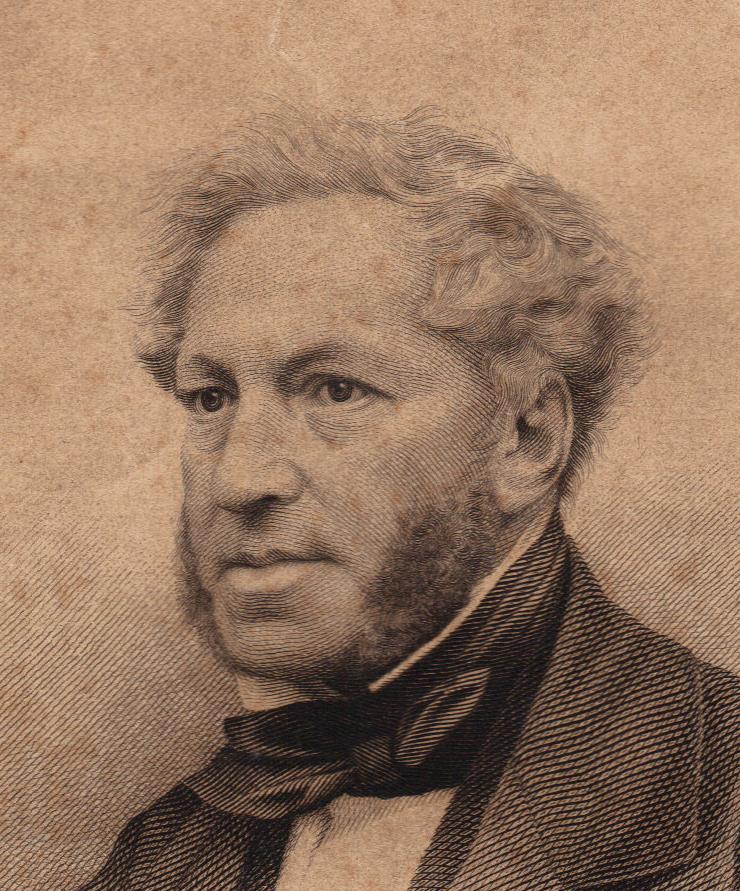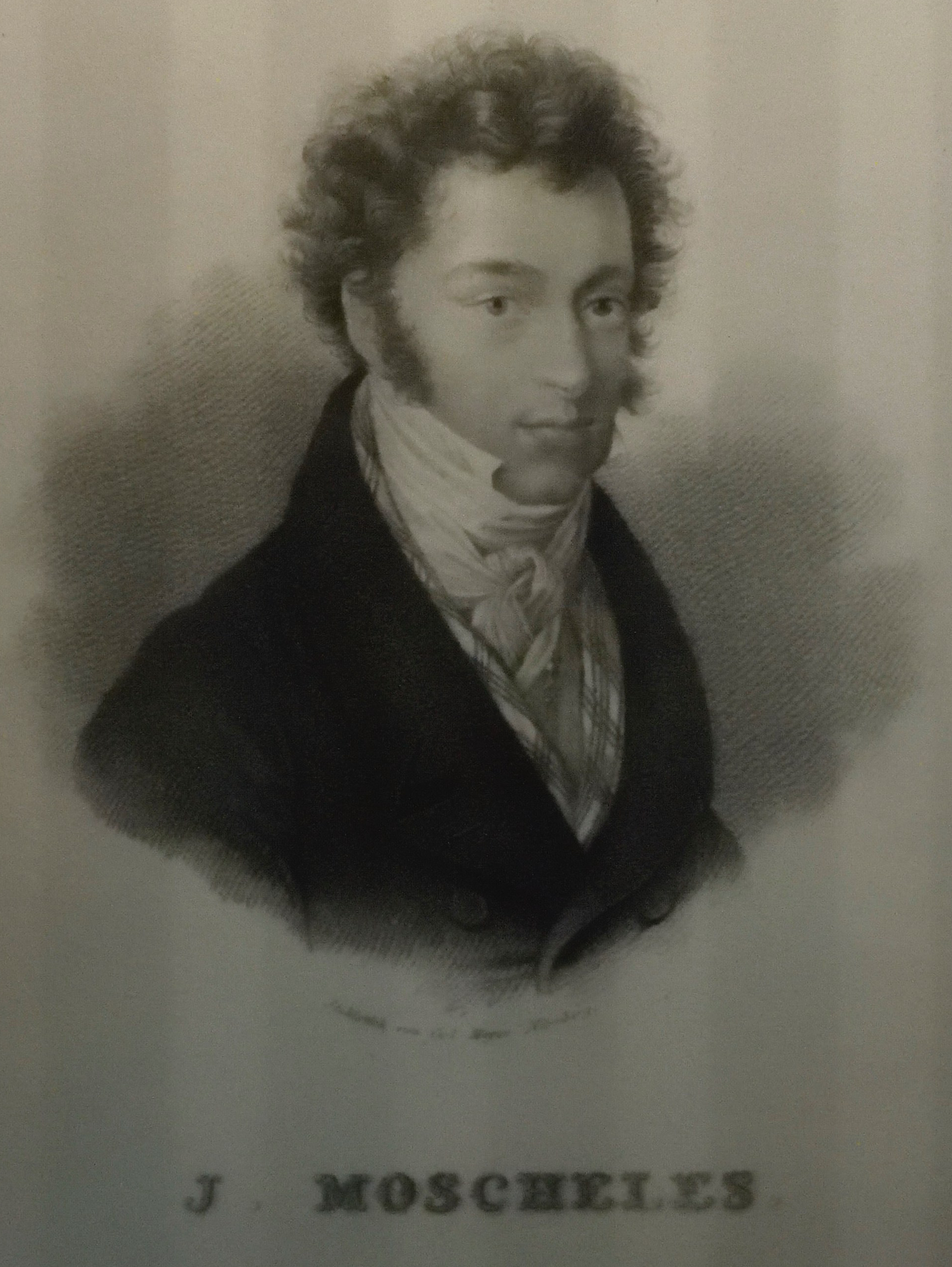In the following post I will give a brief biography of the main points of the composer. A common question that always comes up when you are a PhD student is the obvious one, what is my topic? I am researching the “The Reception of Ignaz Moscheles in the 19th century”. The second question that so followed is “What’s the name of the composer again?”. And then people looked puzzled. So who is Ignaz Moscheles?

To many, the name Ignaz Moscheles does not ring a bell. To some, he was one of the many early 19th century pianists and composers, who unfortunately faded away. Moscheles though, during his time was a well known and appreciated virtuoso pianist, conductor and composer. He was always a great teacher of well known pianists, such as Felix Mendelssohn, Sigismond Thalberg and Henry Litolff, as well as a book editor (he edited and translated into English Beethoven’s biography by Anton Schindler).
Isaac or Isaak Moscheles, as he was firstly named, was born in Prague on May 23, 1794, to a Jewish family. Quoting his great-great grandchild Jerome Roche: “Moscheles had a knack of being in the right place at the right time, mixing with all the right people”. And this is actually true since it seems that he was always at the right place, at the right time where he met many well known prominent people of his time.
At the age of 14, in 1808, he moved to Vienna to pursue further his studies. In Prague he started his musical studies with Dionys Weber, and then in Vienna he continued with Johannn Georg Albrechtsberg and Antonio Salieri who, in 1811 appointed him as Kapellmeister-Abjunct of the Court Theater. Moscheles from an early age developed a passion of Beethoven’s music. In 1810, he got a change to actually meet Beethoven at the shop of the music publisher Domenico Artaria in Vienna:
Presently Artaria called me in, and said, “This is Beethoven!” and, to the composer, “This is the youth of whom I have just been speaking to you.” Beethoven gave me a friendly nod, and he had just heard a favorable account of me. [1]
Then, in 1814 Moscheles was invited by Artaria to write a piano reduction of Beethoven’s Fidelio. The arrangements were corrected and approved by Beethoven before being published. The British Library in London has a few publications of different pieces from Beethoven’s Fidelio that were arranged by Moscheles. Moscheles kept in contact with Beethoven until his last moments. He even helped to arrange to send him financial help in his last moments, 100l, with the Philharmonic Society.
The next important chapter of Moscheles’ life was when he settled in London in 1825. In March 1, he got married to Charlotte Embden in Hamburg, and on May 2 they moved to London where they stayed until 1846. Moscheles’ first appearance in the country was on 11 June 1821 where he performed his own Piano Concerto No.2 in E flat major, Op.56 at the final concert of the Philharmonic Society. At the Philharmonic Society he also appeared as a conductor on 9 April 1832. He firstly conducted a symphony of his own; Symphony No.1 in C major, Op. 81. Three years later, on 27 April, he conducted for the second time his own composition, the overture Jeanne d’Arc, Op.91. In 1859, Moscheles was awarded as an Honorary Member of the Philharmonic Society of London.
From his first appearance, he was already highly praised in the country. His was well known for his Alexander Variations, named The Fall of Paris in England, which was performed by him and from other performers at the time. The Morning Post, called him on 18 June 1821 as the “the great star of the evening” and a “truly great performer”. The Morning Chronicle on the 7th of the following month wrote that he is
a union of some of the best players that we have ever heard ; he has CLEMENTI’S science, CRAMER’S expression, and KALKBRENNER’S brilliancy. His execution is amazing, but this is a quality that ought to be only valued as a mean ; the rope-dancer and the cripple, who without hands, fabricates watch-papers, vanquish difficulties, much more astonishing than any that the musician has to encounter. The merit of this performer consists in his making such a right application of his genius, and such a wise use of the mean acquired by his indefatigable industry, as shew him to be a man of taste and judgement.
So only from these two concert reviews it is observed how highly he was praised and appreciated in the country. Even Schumann when he was a child and heard Moscheles playing in Karlsbad said “I shall take him for an example in everything”. Even though he wasn’t a student of Moscheles, he admired him and thought of him as a role model from a young age. [2]
Although, his reputation faded away, Moscheles offered a great deal to the musical world. In fact in 1837 he introduced his ‘Classical Pianoforte Series’ where he aimed to perform as the only instrumentalist, specifically on the piano. The specific series included early music for the piano by composers such as Bach, Beethoven, Mozart, Purcell and Scarlatti. Nonetheless, even though the series were presented in the newspapers as ‘Classical Pianoforte Series’, Moscheles also included vocal music in the programme which was conducted by Sir George Smart. As claimed by his wife, he did that as a “precaution” in order to “relieve the monotony which people warned him against”since until then instruments did not perform solo in concerts. Moscheles, in the specific series, had also introduced the harpsichord which has not been used in public concerts for a long time.[3] He used one that was built in 1771 and was “in possession of Messrs. Broadwood”.[4] This was advertised as “A selection from the Suites of Lessons (including the celebrated Cat’s Fugue), as originally written for the harpsichord; and by desire, performed on that instrument by Mr. Moscheles, D. Scarlatti”.[5] The advertisement proved that the specific pieces were indeed originally written for the instrument, thus Moscheles decided to perform them in their original form. This was one of his purposes of performing early music; to promote early music and not neglect the previous school.
From 1838, Moscheles started realising the change that was happening in the virtuosic musical world. The new school of music differed from his preferred style.
I play all the new works of the four modern heroes, Thalberg, Chopin, Henselt, and Liszt, and find that their chief effects lie in passages requiring a large grasp and stretch of finger, such as the peculiar build of their hands enables them to execute; I grasp less, but then I am not of a grasping school. With all my admiration for Beethoven I cannot forget Mozart, Cramer, and Hummel. Have they not written much that is noble, with which I have been familiar from early years? Just now the new manner finds more favor, and I endeavor to pursue the middle course between the two schools, by never shrinking from any difficulty, never despising the new effects, and withal retaining the best elements of the old traditions”.[6]
Thus, from then his performances started decreasing. In 1839 he wrote:
The leading features of this school are the cultivation of amazing powers of execution, overwrought sentimentality, and the production of piquant effects by the most rapid changes from the soft to the loud pedal, or by rhythms and modulations, which, if not to be completely repudiated, are only allowable on the rarest occasions. It is quite natural that I should not ally myself to this modern action; a great deal they do, I would not ; their power I could not imitate, although in my own school of playing I feel in full vigor without any trace of age or want of nerve. In my school such a prodigal display of mechanical power was a thing unknown. For the future, should the world take less interest in my performance as an executant, my desire will be the more ardent to cultivate music in accordance with my own taste and convictions. As to how and what I shall compose, this too is veiled in the future. Hitherto I have introduced my works to the public by the medium of my own pianoforte playing; will the musical world when I retire continue to take interest in them? ‘Nous verrons.’ “.[7]

As previously mentioned, he was the teacher of Felix Mendelssohn. Moscheles had developed a different relationship with Mendelssohn in comparison to his other pupils. The two became very close family friends, and Mendelssohn had even christened Moscheles son and named him after him, Felix Moscheles. In 1846, Moscheles accepted a position, by his friend Mendelssohn, as a “Director of Pianoforte Study and Instruction in Performance and Piano Composition” at the Conservatoire of Leipzig (now called The University of Music and Theatre »Felix Mendelssohn Bartholdy«, the oldest music University in Germany). The streets where the Conservatoire in Leipzig is located bear the names of famous composers; such as Mozartstraße, Beethovenstraße, Robert-Schumann-straße. They could not have missed out Moscheles! Moschelesstraße crosses over Sebastian-Bach-Straße. Moscheles taught at the conservatoire until his last breath, on 10 March 1870.
Although, he decided not perform in public anymore, after moving to Leipzig he did not completely abandon the concert stage. There are instances were he performed not only in Leipzig but also in other countries as well. Going back to Jerome Roche’s statement that Moscheles was always ‘in the right place at the right time, mixing with all the right people’, through out his life he met with and performed with distinguished names. Not only with Mendelssohn but with people such as Ludwig van Beethoven, Franz Liszt, Frederick Chopin, Clara Schumann, J. B. Cramer, Sigsmond Thalberg, Friedrich Kalkbrenner and many more!

So observing from his relationships, his praise in the press and his offers in the musical world it is quite surprising that his reputation faded away and his music and even his name is known to few. I was very surprised to see a small portrait of Moscheles in Warsaw when I visited the Fryderyk Chopin Museum.
I have briefly summarised Moscheles’ life. For more detailed information of his life see:
- Mark Kroll, Ignaz Moscheles and the Changing World of Musical Europe (Woodbridge, Suffolk: Boydell Press, 2014).
- Charlotte Moscheles, ed., Recent Music and Musicians, as Described in the Diaries and Correspondence of Ignaz Moscheles, trans. A.D. Coleridge (New York: Henry Holt and Company, 1879).
here are a few CDs available with his music, and there are a few recordings available online on Youtube. You may visit the links if you wish to listen to his fascinating music!

Endnotes:
[1] Anton Schindler, The Life of Beethoven, ed. Ignaz Moscheles (Boston: Oliver Ditson Company, 1840), v-vi.
[2] Clara Schumann, ed., Early Letters of Robert Schumann, trans. by May Herbert (London: G. Bell and Sons, 1888), 131.
[3] Charlotte Moscheles, ed., Recent Music and Musicians, as Described in the Diaries and Correspondence of Ignaz Moscheles, trans. A.D. Coleridge (New York: Henry Holt and Company, 1879), 236.
[4] Ibidem.
[5] The Musical World, February 24, 1837, p. 155.
[6] Moscheles, Recent Music and Musicians, 250.
[7] Ibidem, 255-256.


